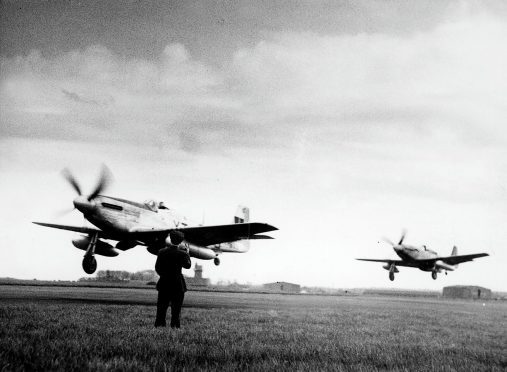On April 7, 1945 Flight Lieutenant Gordon Watt was shot down by the Luftwaffe over Norway during a bombing raid and disappeared from the history books.
But more than 70 years after his Mustang fighter took off from Peterhead only to plummet into a fjord, the work of a Norwegian writer has revealed he survived the crash and eventually emigrated to Australia.
Now, with the unlikely help of a Welsh amateur historian, Gareth Lewis, and the wife of a Tasmanian premier, Caroline Rundle, historian Kjell Arve Vorland has set up a new exhibition about the incident and Peterhead’s role in World War Two’s Norwegian Campaign.
Flt Lt Watt served as a fighter pilot in RAF 65 Squadron based at Peterhead. On the day he vanished from the skies, the young airman was providing escort for a mass Beaufighter and Mosquito attack on German shipping in Norwegian waters.
During a fierce battle, he was attacked by two German fighters and was shot down over Sognefjord, presumed dead.
And yet, while he was researching 65 Squadron’s sorties over Norway, Mr Vorland made the remarkable discovery that Gordon Watt had not perished in the battle but bailed out, as the prelude to being rescued by fishermen and subsequently captured by German forces.
After a month-long internment which ended when the Nazi high command declared Germany’s unconditional surrender to the Allies in May 1945, Flt Lt Watt returned to civilian life as a commercial pilot.
In the 1970s, he and his wife, Jeannette, emigrated to Tasmania and his story went untold until Mr Vorland tracked down his daughter Caroline.
In 2013, Mrs Rundle, the wife of former Tasmanian premier, Tony Rundle, flew with her husband to met Mr Vorland at the air museum at Herdla airfield where German fighters were once stationed.
Since that visit, Mr Vorland has continued his quest to unearth the details of 65 Squadron’s heroics and has located the wreckage of Mustang YT-P on the sea bed.
Now, the historian and journalist is organising a new exhibition at Herdla Museum and said last night: “I have been doing research regarding the Second World War for over 20 years, and I find this story very special.
“One of the reasons for me to further pursue this incident, is to obtain more information and hopefully new photos to use in a new display at the museum at Herdla.
“Flieghorst Herdla was the German airbase that the Luftwaffe units who fought against the squadrons from Peterhead were based.”
Mr Vorland hopes renewed publicity about the story will prompt fresh revelations about the Norwegian campaign.
He added: “Gordon Watt was the lucky one. I am still searching for Flight Lieutenant Ian G Stewart from the same squadron who was lost on March 25, 1945.
“After being in RAF service during the whole war, in many different theatres, he lost his life, just a matter of weeks before the war ended.”
The aerial war against German forces occupying Norway was waged largely from Peterhead where the RAF fighter squadrons were based.
Attack squadrons of Beaufighter and Mosquito bombers were stationed at the nearby Dallachy airfield and worked in tandem to target German shipping across the North Sea.
